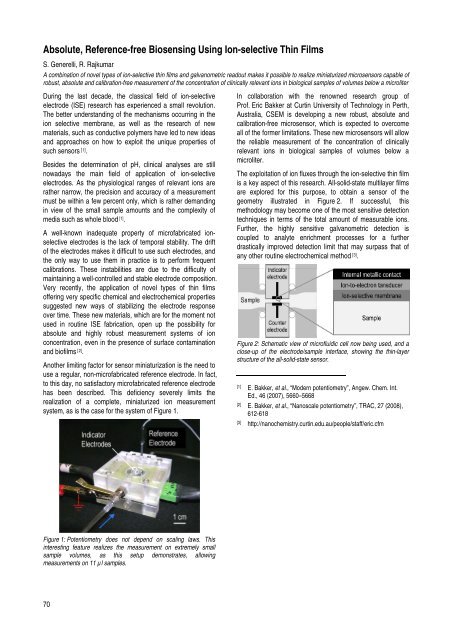CSEM Scientific and Technical Report 2008
CSEM Scientific and Technical Report 2008
CSEM Scientific and Technical Report 2008
Create successful ePaper yourself
Turn your PDF publications into a flip-book with our unique Google optimized e-Paper software.
Absolute, Reference-free Biosensing Using Ion-selective Thin Films<br />
S. Generelli, R. Rajkumar<br />
A combination of novel types of ion-selective thin films <strong>and</strong> galvanometric readout makes it possible to realize miniaturized microsensors capable of<br />
robust, absolute <strong>and</strong> calibration-free measurement of the concentration of clinically relevant ions in biological samples of volumes below a microliter<br />
During the last decade, the classical field of ion-selective<br />
electrode (ISE) research has experienced a small revolution.<br />
The better underst<strong>and</strong>ing of the mechanisms occurring in the<br />
ion selective membrane, as well as the research of new<br />
materials, such as conductive polymers have led to new ideas<br />
<strong>and</strong> approaches on how to exploit the unique properties of<br />
such sensors [1] .<br />
Besides the determination of pH, clinical analyses are still<br />
nowadays the main field of application of ion-selective<br />
electrodes. As the physiological ranges of relevant ions are<br />
rather narrow, the precision <strong>and</strong> accuracy of a measurement<br />
must be within a few percent only, which is rather dem<strong>and</strong>ing<br />
in view of the small sample amounts <strong>and</strong> the complexity of<br />
media such as whole blood [1] .<br />
A well-known inadequate property of microfabricated ionselective<br />
electrodes is the lack of temporal stability. The drift<br />
of the electrodes makes it difficult to use such electrodes, <strong>and</strong><br />
the only way to use them in practice is to perform frequent<br />
calibrations. These instabilities are due to the difficulty of<br />
maintaining a well-controlled <strong>and</strong> stable electrode composition.<br />
Very recently, the application of novel types of thin films<br />
offering very specific chemical <strong>and</strong> electrochemical properties<br />
suggested new ways of stabilizing the electrode response<br />
over time. These new materials, which are for the moment not<br />
used in routine ISE fabrication, open up the possibility for<br />
absolute <strong>and</strong> highly robust measurement systems of ion<br />
concentration, even in the presence of surface contamination<br />
<strong>and</strong> biofilms [2] .<br />
Another limiting factor for sensor miniaturization is the need to<br />
use a regular, non-microfabricated reference electrode. In fact,<br />
to this day, no satisfactory microfabricated reference electrode<br />
has been described. This deficiency severely limits the<br />
realization of a complete, miniaturized ion measurement<br />
system, as is the case for the system of Figure 1.<br />
Figure 1: Potentiometry does not depend on scaling laws. This<br />
interesting feature realizes the measurement on extremely small<br />
sample volumes, as this setup demonstrates, allowing<br />
measurements on 11 µl samples.<br />
70<br />
In collaboration with the renowned research group of<br />
Prof. Eric Bakker at Curtin University of Technology in Perth,<br />
Australia, <strong>CSEM</strong> is developing a new robust, absolute <strong>and</strong><br />
calibration-free microsensor, which is expected to overcome<br />
all of the former limitations. These new microsensors will allow<br />
the reliable measurement of the concentration of clinically<br />
relevant ions in biological samples of volumes below a<br />
microliter.<br />
The exploitation of ion fluxes through the ion-selective thin film<br />
is a key aspect of this research. All-solid-state multilayer films<br />
are explored for this purpose, to obtain a sensor of the<br />
geometry illustrated in Figure 2. If successful, this<br />
methodology may become one of the most sensitive detection<br />
techniques in terms of the total amount of measurable ions.<br />
Further, the highly sensitive galvanometric detection is<br />
coupled to analyte enrichment processes for a further<br />
drastically improved detection limit that may surpass that of<br />
any other routine electrochemical method [3] .<br />
Figure 2: Schematic view of microfluidic cell now being used, <strong>and</strong> a<br />
close-up of the electrode/sample interface, showing the thin-layer<br />
structure of the all-solid-state sensor.<br />
[1] E. Bakker, et al., “Modern potentiometry”, Angew. Chem. Int.<br />
Ed., 46 (2007), 5660–5668<br />
[2] E. Bakker, et al., “Nanoscale potentiometry”, TRAC, 27 (<strong>2008</strong>),<br />
612-618<br />
[3] http://nanochemistry.curtin.edu.au/people/staff/eric.cfm








